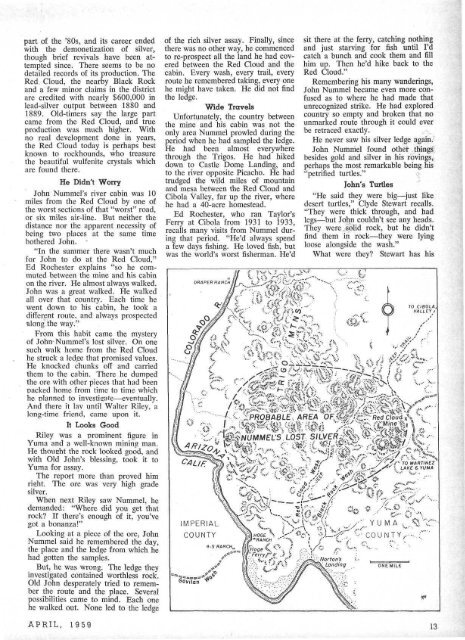april on the desert - Desert Magazine of the Southwest
april on the desert - Desert Magazine of the Southwest
april on the desert - Desert Magazine of the Southwest
Create successful ePaper yourself
Turn your PDF publications into a flip-book with our unique Google optimized e-Paper software.
part <strong>of</strong> <strong>the</strong> '80s, and its career ended<br />
with <strong>the</strong> dem<strong>on</strong>etizati<strong>on</strong> <strong>of</strong> silver,<br />
though brief revivals have been attempted<br />
since. There seems to be no<br />
detailed records <strong>of</strong> its producti<strong>on</strong>. The<br />
Red, Cloud, <strong>the</strong> nearby Black Rock<br />
and a few minor claims in <strong>the</strong> district<br />
are credited with nearly $600,000 in<br />
lead-silver output between 1880 and<br />
1889. Old-timers say <strong>the</strong> large part<br />
came from <strong>the</strong> Red Cloud, and true<br />
producti<strong>on</strong> was much higher. With<br />
no real development d<strong>on</strong>e in years,<br />
<strong>the</strong> Red Cloud today is perhaps best<br />
known to rockhounds, who treasure<br />
<strong>the</strong> beautiful wulfenite crystals which<br />
are found <strong>the</strong>re.<br />
He Didn't Worry<br />
John NummePs river cabin was 10<br />
miles from <strong>the</strong> Red Cloud by <strong>on</strong>e <strong>of</strong><br />
<strong>the</strong> worst secti<strong>on</strong>s <strong>of</strong> that "worst" road,<br />
or six miles air-line. But nei<strong>the</strong>r <strong>the</strong><br />
distance nor <strong>the</strong> apparent necessity <strong>of</strong><br />
being two places at <strong>the</strong> same time<br />
bo<strong>the</strong>red John.<br />
"In <strong>the</strong> summer <strong>the</strong>re wasn't much<br />
for John to do at <strong>the</strong> Red Cloud,"<br />
Ed Rochester explains "so he commuted<br />
between <strong>the</strong> mine and his cabin<br />
<strong>on</strong> <strong>the</strong> river. He almost always walked.<br />
John was a great walked. He walked<br />
all over that country. Each time he<br />
went down to his cabin, he took a<br />
different route, and always prospected<br />
al<strong>on</strong>g <strong>the</strong> way."<br />
From this habit came <strong>the</strong> mystery<br />
<strong>of</strong> John NummePs lost silver. On <strong>on</strong>e<br />
such walk home from <strong>the</strong> Red Cloud<br />
he struck a ledge that promised values.<br />
He knocked chunks <strong>of</strong>f and carried<br />
<strong>the</strong>m to <strong>the</strong> cabin. There he dumped<br />
<strong>the</strong> ore with o<strong>the</strong>r pieces that had been<br />
packed home from time to time which<br />
he planned to investigate—eventually.<br />
And <strong>the</strong>re it lav until Walter Riley, a<br />
l<strong>on</strong>g-time friend, came up<strong>on</strong> it.<br />
It Looks Good<br />
Riley was a prominent figure in<br />
Yuma and a well-known mining man.<br />
He thought <strong>the</strong> rock looked good, and<br />
with Old John's blessing, took it to<br />
Yuma for assay.<br />
The report more than proved him<br />
right. The ore was very high grade<br />
silver.<br />
When next Riley saw Nummel, he<br />
demanded: "Where did you get that<br />
rock? If <strong>the</strong>re's enough <strong>of</strong> it, you've<br />
got a b<strong>on</strong>anza!"<br />
Looking at a piece <strong>of</strong> <strong>the</strong> ore, John<br />
Nummel said he remembered <strong>the</strong> day,<br />
<strong>the</strong> place and <strong>the</strong> ledge from which he<br />
had gotten <strong>the</strong> samples.<br />
But, he was wr<strong>on</strong>g. The ledge <strong>the</strong>y<br />
investigated c<strong>on</strong>tained worthless rock.<br />
Old John desperately tried to remember<br />
<strong>the</strong> route and <strong>the</strong> place. Several<br />
possibilities came to mind. Each <strong>on</strong>e<br />
he walked out. N<strong>on</strong>e led to <strong>the</strong> ledge<br />
APRIL, 1959<br />
<strong>of</strong> <strong>the</strong> rich silver assay. Finally, since<br />
<strong>the</strong>re was no o<strong>the</strong>r way, he commenced<br />
to re-prospect all <strong>the</strong> land he had covered<br />
between <strong>the</strong> Red Cloud and <strong>the</strong><br />
cabin. Every wash, every trail, every<br />
route he remembered taking, ever)' <strong>on</strong>e<br />
he might have taken. He did not find<br />
<strong>the</strong> ledge.<br />
Wide Travels<br />
Unfortunately, <strong>the</strong> country between<br />
<strong>the</strong> mine and his cabin was not <strong>the</strong><br />
<strong>on</strong>ly area Nummel prowled during <strong>the</strong><br />
period when he had sampled <strong>the</strong> ledge.<br />
He had been almost everywhere<br />
through <strong>the</strong> Trigos. He had hiked<br />
down to Castle Dome Landing, and<br />
to <strong>the</strong> river opposite Picacho. He had<br />
trudged <strong>the</strong> wild miles <strong>of</strong> mountain<br />
and mesa between <strong>the</strong> Red Cloud and<br />
Cibola Valley, far up <strong>the</strong> river, where<br />
he had a 40-acre homestead.<br />
Ed Rochester, who ran Taylor's<br />
Ferry at Cibola from 1931 to 1933,<br />
recalls many visits from Nummel during<br />
that period. "He'd always spend<br />
a few days fishing. He loved fish, but<br />
was <strong>the</strong> world's worst fisherman. He'd<br />
DRAPER RAN<br />
IMPERIAL<br />
COUNTY<br />
4-S RANCH<br />
r" 5 '.„.- •.,..= __*. = t ,,,;c ''•••"<br />
sit <strong>the</strong>re at <strong>the</strong> ferry, catching nothing<br />
and just starving for fish until I'd<br />
catch a bunch and cook <strong>the</strong>m and fill<br />
him up. Then he'd hike back to <strong>the</strong><br />
Red Cloud."<br />
Remembering his many wanderings,<br />
John Nummel became even more c<strong>on</strong>fused<br />
as to where he had made that<br />
unrecognized strike. He had explored<br />
country so empty and broken that no<br />
unmarked route through it could ever<br />
be retraced exactly.<br />
He never saw his silver ledge again.'<br />
John Nummel found o<strong>the</strong>r things;<br />
besides gold and silver in his rovings,<br />
perhaps <strong>the</strong> most remarkable being his<br />
"petrified turtles." ;<br />
John's Turtles<br />
"He said <strong>the</strong>y were big—just like<br />
<strong>desert</strong> turtles," Clyde Stewart recalls.<br />
"They were thick through, and had<br />
legs—but John couldn't see any heads.<br />
They were solid rock, but he didn't<br />
find <strong>the</strong>m in rock—<strong>the</strong>y were lying<br />
loose al<strong>on</strong>gside <strong>the</strong> wash."<br />
What were <strong>the</strong>y? Stewart has his<br />
TO CIBOLA<br />
VALLEY i<br />
13

















